Apache Spark 2.3.0 重要特性介绍
文章标题
Introducing Apache Spark 2.3
Apache Spark 2.3 介绍
Now Available on Databricks Runtime 4.0
现在可以在Databrcks Runtime 4.0上使用。
作者介绍
Sameer Agarwal, Xiao Li, Reynold Xin and Jules Damji
文章正文:
Today we are happy to announce the availability of Apache Spark 2.3.0 on Databricks as part of its Databricks Runtime 4.0. We want to thank the Apache Spark community for all their valuable contributions to Spark 2.3 release.
今天,我们很高兴地

Continuing with the objectives to make Spark faster, easier, and smarter, Spark 2.3 marks a major milestone for Structured Streaming by introducing low-latency continuous processing and stream-to-stream joins; boosts PySpark by improving performance with pandas UDFs; and runs on Kubernetes clusters by providing native support for Apache Spark applications.
In addition to extending new functionality to SparkR, Python, MLlib, and GraphX, the release focuses on usability, stability, and refinement, resolving over 1400 tickets. Other salient features from Spark contributors include:
- DataSource v2 APIs [SPARK-15689, SPARK-20928]
- Vectorized ORC reader [SPARK-16060]
- Spark History Server v2 with K-V store [SPARK-18085]
- Machine Learning Pipeline API model scoring with Structured Streaming [SPARK-13030, SPARK-22346, SPARK-23037]
- MLlib Enhancements Highlights [SPARK-21866, SPARK-3181, SPARK-21087, SPARK-20199]
- Spark SQL Enhancements [SPARK-21485, SPARK-21975, SPARK-20331, SPARK-22510, SPARK-20236]
In this blog post, we briefly summarize some of the high-level features and improvements, and in the coming days, we will publish in-depth blogs for these features. For a comprehensive list of major features across all Spark components and JIRAs resolved, read the Apache Spark 2.3.0 release notes.
1、Continuous Stream Processing at Millisecond Latencies
Structured Streaming in Apache Spark 2.0 decoupled micro-batch processing from its high-level APIs for a couple of reasons. First, it made developer’s experience with the APIs simpler: the APIs did not have to account for micro-batches. Second, it allowed developers to treat a stream as an infinite table to which they could issue queries as they would a static table.
However, to provide developers with different modes of stream processing, we introduce a new millisecond low-latency mode of streaming: continuous mode.
Under the hood, the structured streaming engine incrementally executed query computations in micro-batches, dictated by a trigger interval, with tolerable latencies suitable for most real-world streaming applications.
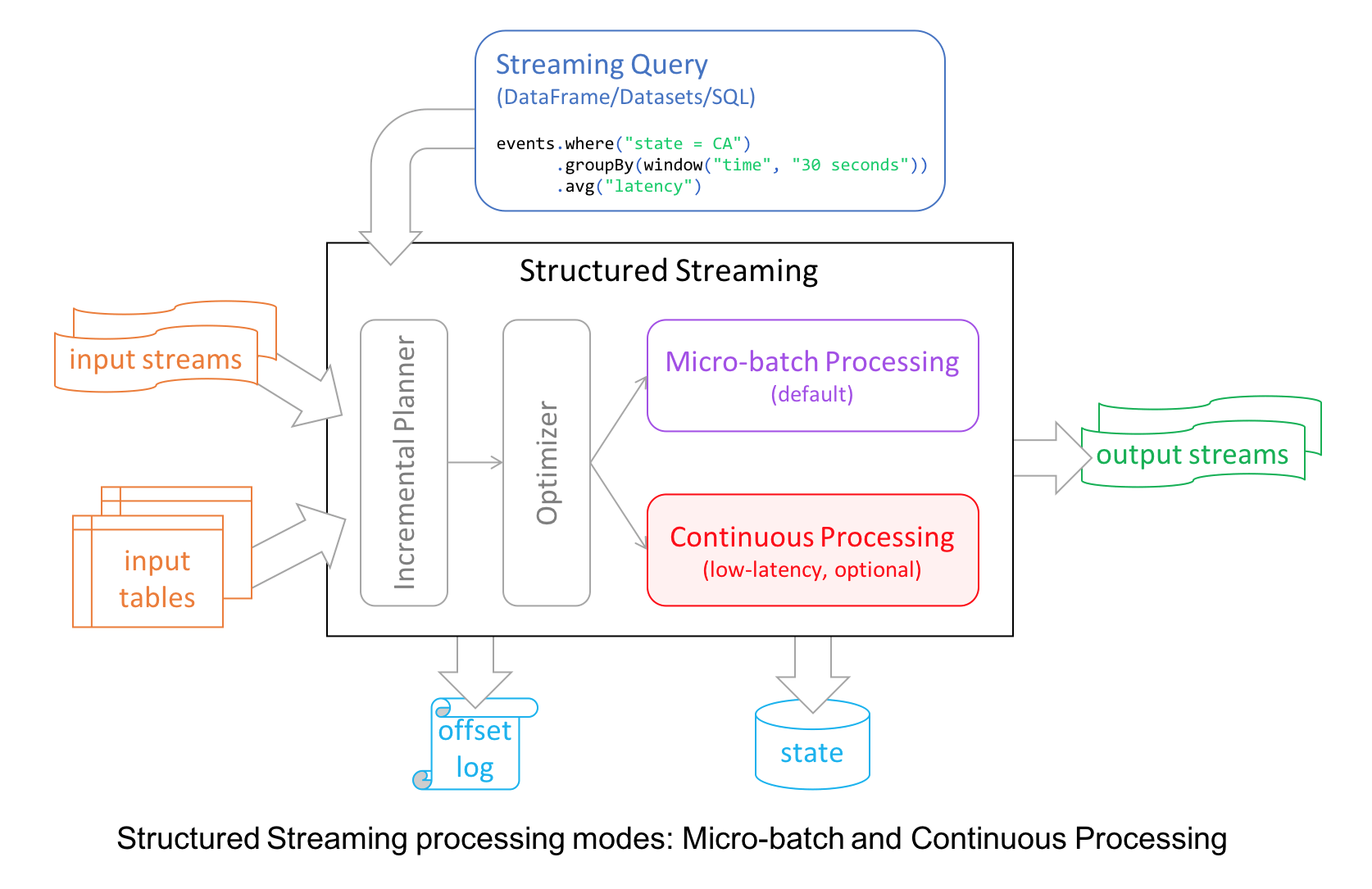
For continuous mode, instead of micro-batch execution, the streaming readers continuously poll source and process data rather than read a batch of data at a specified trigger interval. By continuously polling the sources and processing data, new records are processed immediately upon arrival, as shown in the timeline figure below, reducing latencies to milliseconds and satisfying low-level latency requirements.

As for operations, it currently supports map-like Dataset operations such as projections or selections and SQL functions, with the exception of current_timestamp(), current_date() and aggregate functions. As well as supporting Apache Kafka as a source and sink, continuous mode currently supports console and memory as sinks, too.
Now developers can elect either mode—continuous or micro-batching—depending on their latency requirements to build real-time streaming applications at scale while benefiting from the fault-tolerance and reliability guarantees that Structured Streaming engine affords.
In short, the continuous mode in Spark 2.3 is experimental and it offers the following:
- end-to-end millisecond low latencies
- provides at-least-once guarantees.
- supports map-like Dataset operations
In this technical blog on Continuous Processing mode, we illustrate how to use it, its merits, and
how developers can write continuous streaming applications with millisecond low-latency requirements.
2、Stream-to-Stream Joins
While Structured Streaming in Spark 2.0 has supported joins between a streaming DataFrame/Dataset and a static one, this release introduces the much awaited stream-to-stream joins, both inner and outer joins for numerous real-time use cases.
The canonical use case of joining two streams is that of ad-monetization. For instance, an impression stream and an ad-click stream share a common key (say, adId) and relevant data on which you wish to conduct streaming analytics, such as, which adId led to a click.
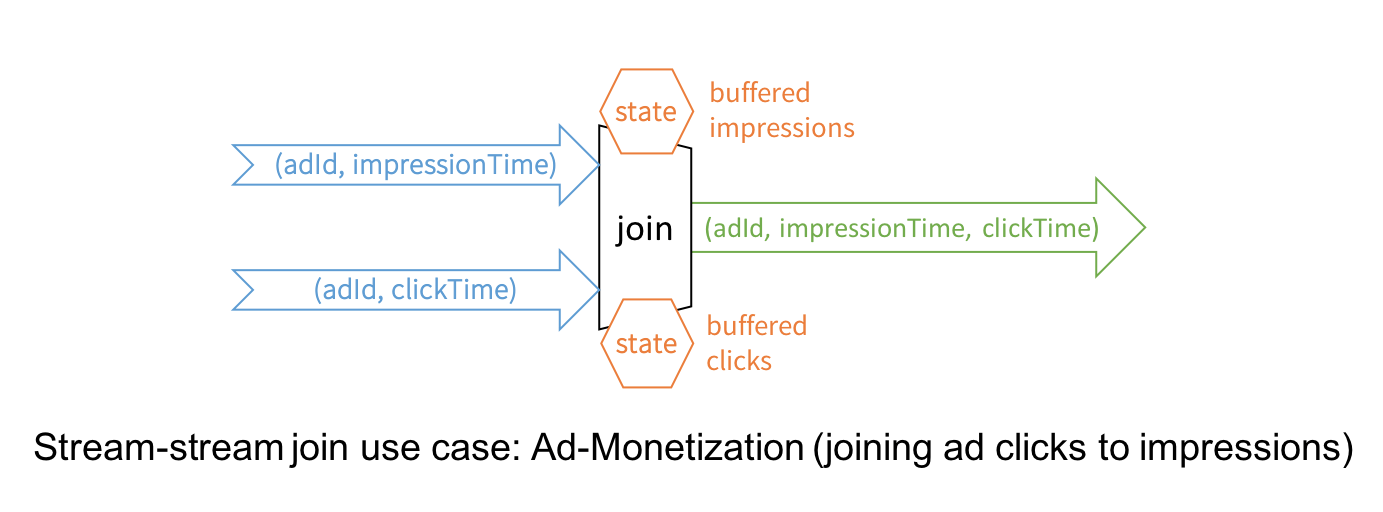
While conceptually the idea is simple, stream-to-stream joins resolve a few technical challenges. For example, they:
- handle delayed data by buffering late events as streaming “state” until matching event is found from the other stream
- limit the buffer from growing and consuming memory with watermarking, which allows tracking of event-time and accordingly clearing of old state
- allow a user to control the tradeoff between the resources consumed by state and the maximum delay handled by the query
- maintain consistent SQL join semantics between static joins and streaming joins
In this technical blog, we dive deeper into streams-to-stream joins.
3、Apache Spark and Kubernetes
No surprise that two popular open source projects Apache Spark and Kubernetes combine their functionality and utility to provide distributed data processing and orchestration at scale. In Spark 2.3, users can launch Spark workloads natively on a Kubernetes cluster leveraging the new Kubernetes scheduler backend. This helps achieve better resource utilization and multi-tenancy by enabling Spark workloads to share Kubernetes clusters with other types of workloads.
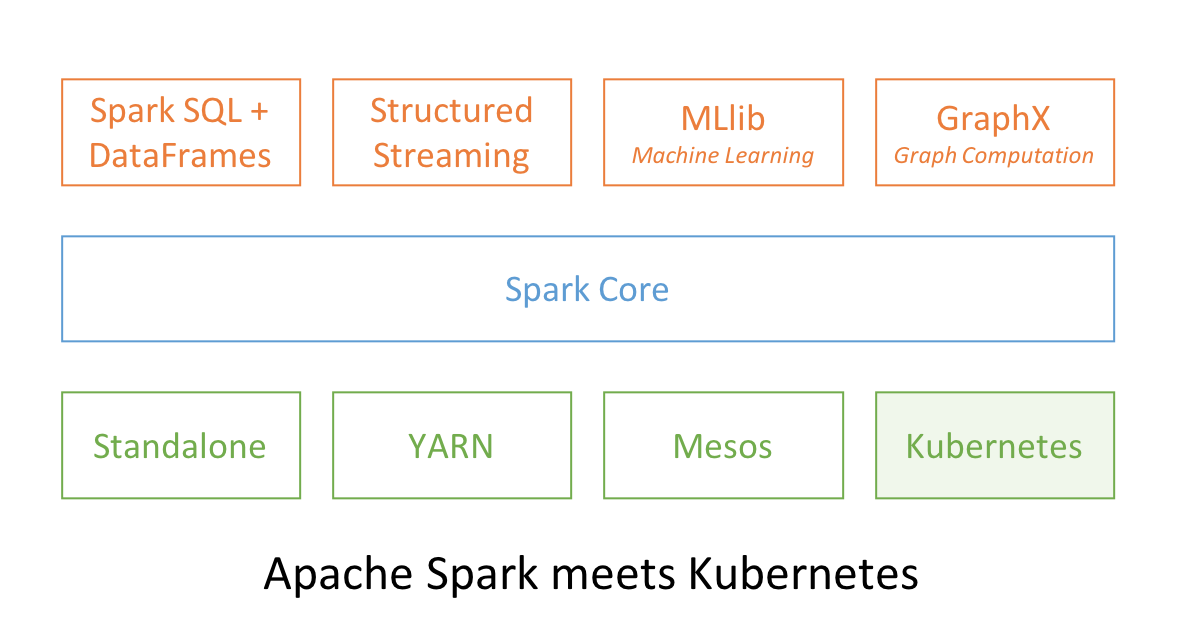
Also, Spark can employ all the administrative features such as Resource Quotas, Pluggable Authorization, and Logging. What’s more, it’s as simple as creating a docker image and setting up the RBAC to start employing your existing Kubernetes cluster for your Spark workloads.
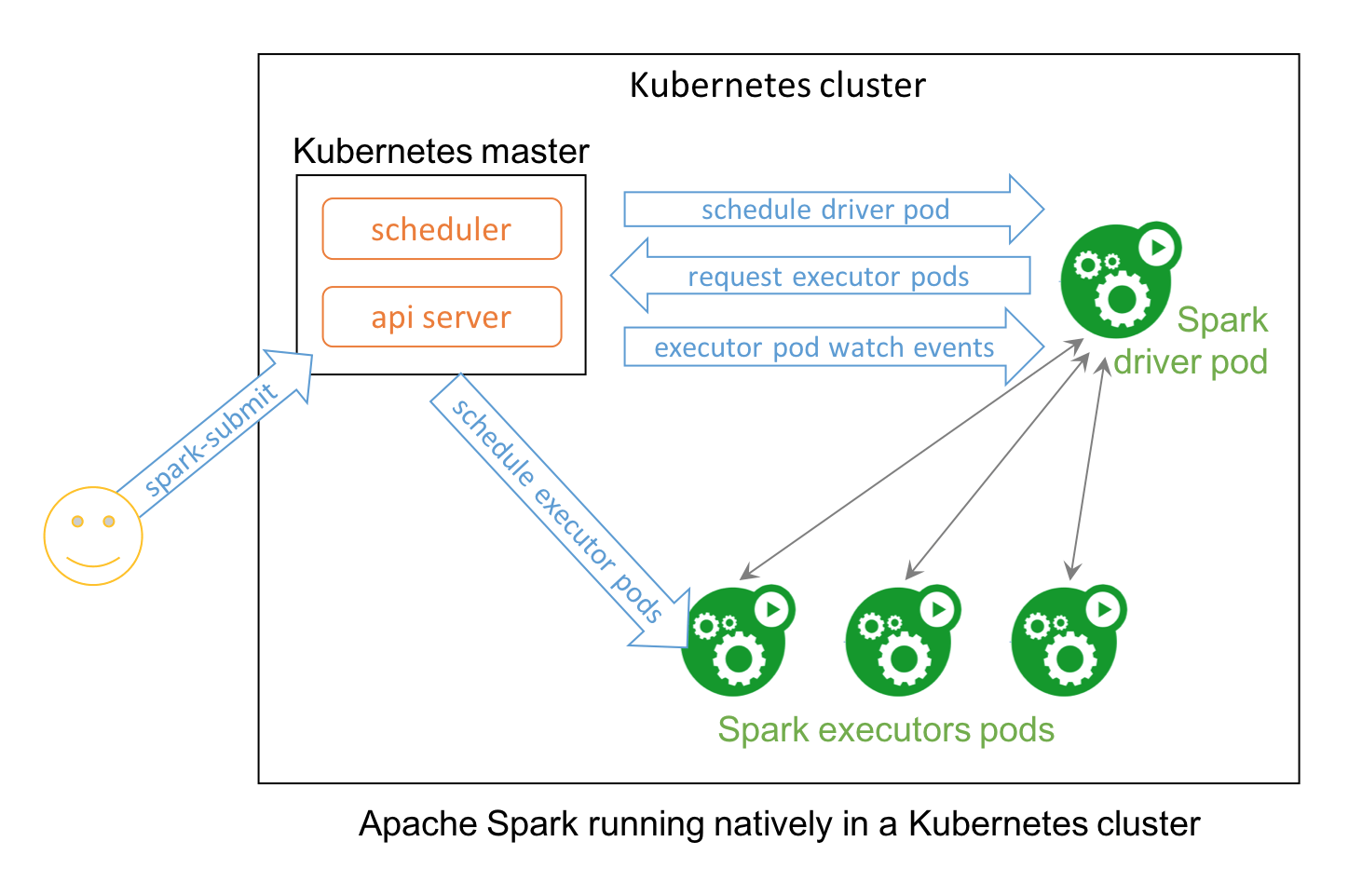
This technical blog explains how you can use Spark natively with Kubernetes and how to get involved in this community endeavor.
4、Pandas UDFs for PySpark
Pandas UDFs, also called Vectorized UDFs, is a major boost to PySpark performance. Built on top of Apache Arrow, they afford you the best of both worlds—the ability to define low-overhead, high-performance UDFs and write entirely in Python.
In Spark 2.3, there are two types of Pandas UDFs: scalar and grouped map. Both are now available in Spark 2.3. Li Jin of Two Sigma had penned an earlier blog, explaining their usage through four examples: Plus One, Cumulative Probability, Subtract Mean, Ordinary Least Squares Linear Regression.
Running some micro benchmarks, Pandas UDFs demonstrate orders of magnitude better performance than row-at-time UDFs.
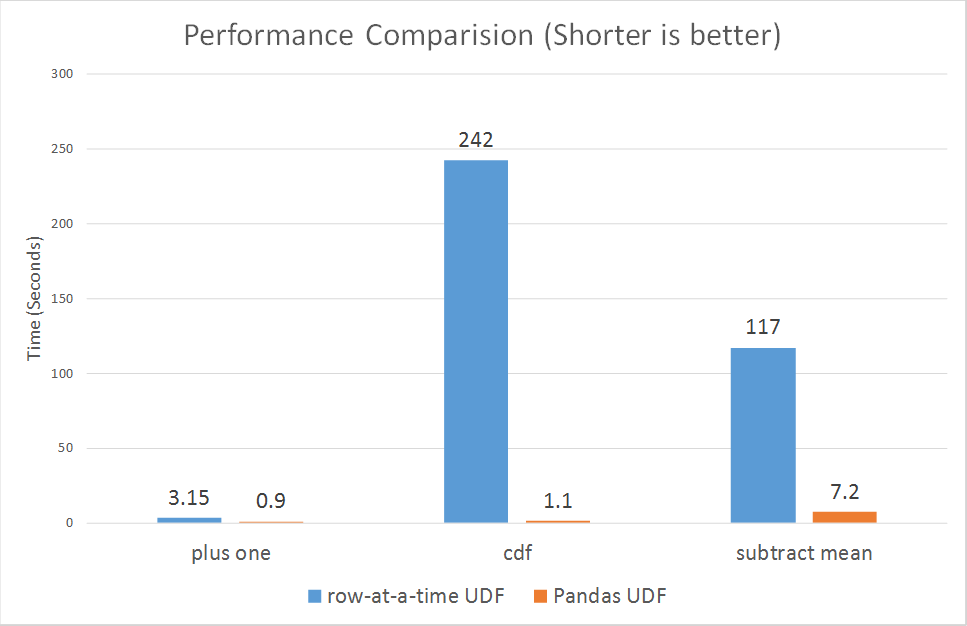
According to Li Jin and other contributors, they plan to introduce support for Pandas UDFs in aggregations and window functions, and its related work can be tracked in SPARK-22216.
5、MLlib Improvements
Spark 2.3 includes many MLlib improvements for algorithms and features, performance and scalability, and usability. We mention three highlights.
First, for moving MLlib models and Pipelines to production, fitted models and Pipelines now work within Structured Streaming jobs. Some existing Pipelines will require modifications to make predictions in streaming jobs, so look for upcoming blog posts on migration tips.
Second, to enable many Deep Learning image analysis use cases, Spark 2.3 introduces an ImageSchema [SPARK-21866] for representing images in Spark DataFrames, plus utilities for loading images from common formats.
And finally, for developers, Spark 2.3 introduces improved APIs in Python for writing custom algorithms, including a UnaryTransformer for writing simple custom feature transformers and utilities for automating ML persistence for saving and loading algorithms. See this blog post for details.
参考文献:
Apache Spark 2.3.0 重要特性介绍的更多相关文章
- Apache Spark 2.2.0新特性介绍(转载)
这个版本是 Structured Streaming 的一个重要里程碑,因为其终于可以正式在生产环境中使用,实验标签(experimental tag)已经被移除.在流系统中支持对任意状态进行操作:A ...
- Apache Spark 2.2.0 新特性详细介绍
本章内容: 待整理 参考文献: Apache Spark 2.2.0新特性详细介绍 Introducing Apache Spark 2.2
- Apache Spark 1.6公布(新特性介绍)
Apache Spark 1.6公布 CSDN大数据 | 2016-01-06 17:34 今天我们很高兴可以公布Apache Spark 1.6,通过该版本号,Spark在社区开发中达到一个重要的里 ...
- Hadoop3.0新特性介绍,比Spark快10倍的Hadoop3.0新特性
Hadoop3.0新特性介绍,比Spark快10倍的Hadoop3.0新特性 Apache hadoop 项目组最新消息,hadoop3.x以后将会调整方案架构,将Mapreduce 基于内存+io+ ...
- Apache Spark 2.2.0 中文文档
Apache Spark 2.2.0 中文文档 - 快速入门 | ApacheCN Geekhoo 关注 2017.09.20 13:55* 字数 2062 阅读 13评论 0喜欢 1 快速入门 使用 ...
- webpack 4.0.0-beta.0 新特性介绍
webpack 可以看做是模块打包机.它做的事情是:分析你的项目结构,找到JavaScript模块以及其它的一些浏览器不能直接运行的拓展语言(Scss,TypeScript等),并将其打包为合适的格式 ...
- Apache Spark 2.2.0 正式发布
本章内容: 待整理 参考文献: Apache Spark 2.2.0正式发布 Spark Release 2.2.0
- Pivotal Greenplum 6.0 新特性介绍
Pivotal Greenplum 6.0 新特性介绍 在1月12日举办的Greenplum开源有道智数未来技术研讨会上,Pivotal中国研发中心Greenplum 产品经理李阳向大家介绍了Pi ...
- [转帖]Pivotal Greenplum 6.0 新特性介绍
Pivotal Greenplum 6.0 新特性介绍 https://cloud.tencent.com/developer/news/391063 原来 greenplum 也是基于pg研发的. ...
随机推荐
- BZOJ1053 [HAOI2007]反素数ant 数论
欢迎访问~原文出处——博客园-zhouzhendong 去博客园看该题解 传送门 - BZOJ1053 题目描述 对于任何正整数x,其约数的个数记作g(x).例如g(1)=1.g(6)=4.如果某个正 ...
- 【Java】 剑指offer(41) 数据流中的中位数
本文参考自<剑指offer>一书,代码采用Java语言. 更多:<剑指Offer>Java实现合集 题目 如何得到一个数据流中的中位数?如果从数据流中读出奇数个数值,那么中 ...
- 005.HAProxy+Keepalived高可用负载均衡
一 基础准备 1.1 部署环境及说明 系统OS:CentOS 6.8 64位 HAProxy软件:HA-Proxy version 1.5.18 Keepalived软件:keepalived-1.3 ...
- 如何使用redis设计关系数据库
目录 redis设计关系数据库 前言 设计用户信息表结构 hash存储记录 set存储id 图示 索引/查询: 1.select 查询所有记录 : 类似sql的select from table_na ...
- Running multiple commands in one line in shell
You are using | (pipe) to direct the output of a command into another command. What you are lookin ...
- TCO 2015 1A Hard.Revmatching(Hall定理)
\(Description\) 给定一个\(n\)个点的二分图,每条边有边权.求一个边权最小的边集,使得删除该边集后不存在完备匹配. \(n\leq20\). \(Solution\) 设点集为\(S ...
- Eclipse 重构
使用重构工具可以快捷地将代码变成整洁而高度模块化的代码. Rename Rename 是 Eclipse 中最常用的重构.利用这个重构,可以对变量.类.方法.包.文件夹及几乎任何的 Java 标识符进 ...
- U3D面试题
直接上新.... 什么是协同程序?答:在主线程运行时同时开启另一段逻辑处理,来协助当前程序的执行.换句话说,开启协程就是开启一个可以与程序并行的逻辑.可以用来控制运动.序列以及对象的行为. Unity ...
- linux和CentOS下网卡启动、配置等ifcfg-eth0教程(转自)
转自:http://www.itokit.com/2012/0415/73593.html it 动力总结系统安装好后,通过以下二个步骤就可以让你的系统正常上网(大多正常情况下).步骤1.配置/etc ...
- STL——配接器、常用算法使用
学习STL,必然会用到它里面的适配器和一些常用的算法.它们都是STL中的重要组成部分. 适配器 在STL里可以用一些容器适配得到适配器.例如其中的stack和queue就是由双端队列deque容器适配 ...
